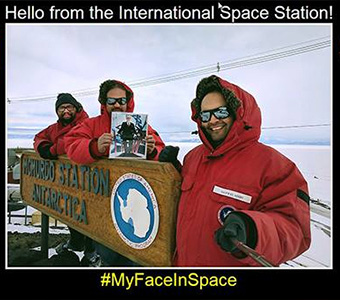|
Testing a Space-Communications Technology in Antarctica That May One Day have Applications in Polar Research 
National Science Foundation Posted November 27, 2017 Image: NASA / (Left to right): Mark Sinkiat, Peter Fetterer (with photo of National Science Board - NSB Member Vinton G. Cerf), and Salem El-nimri at McMurdo Station. On Nov. 20, a "selfie" snapped at NSF’s McMurdo Station in Antarctica was transmitted to the International Space Station using a technology that may one day enable a future interplanetary internet. Called Disruption Tolerant Networking (DTN), the technology is NASA’s solution to reliable interplanetary data transmissions, in which vast distances or alignments of celestial bodies may disrupt communications. Vinton Cerf, a member of the National Science Board, a NASA Jet Propulsion Laboratory Distinguished Visiting Scientists is a leader in the development of DTN. Though Antarctic researchers are not communicating across interplanetary distances, McMurdo’s remote location and telecommunications infrastructure make it an ideal candidate to benefit from DTN. DTN groups data and transmits as many bundles as it can when a communication path opens. If a bundle fails to transmit, it goes into storage and waits for the next communication path to open, then sends it. If the bundles were all part of a single file, the file can be reassembled at the final destination. “We’re cutting our teeth on this software, in real field conditions,” said Patrick Smith, technology development manager for polar research support with the NSF-managed U.S. Antarctic Program. “The simplicity of transmitting from a smart phone could have significant implications for increasing and diversifying the science we support in the polar regions. This represents a vision of how our remote autonomous field research instrumentation might operate one day.” Starting at McMurdo, DTN software on a mobile phone sent the picture on its journey to the International Space Station. The bundles traveled from the McMurdo ground station to NASA’s White Sands Complex via the Tracking and Data Relay Satellite (TDRS). Then, a series of DTN nodes forwarded the bundles to NASA Marshall Space Flight Center in Huntsville, Alabama, which is the access point to the operational space station DTN network. The bundles were forwarded to the space station via another TDRS link where they were then routed to the Telescience Resource Kit (TReK) demonstration payload. The final DTN node extracted the picture data from the DTN bundles that originated from Antarctica. The payload reassembled the original picture and displayed it onboard the station. Read more in a NASA news feature here: https://www.nasa.gov/feature/antarctic-selfie-s-journey-to-space-via-disruption-tolerant-networking
|
Testing a Space-Communications Technology in Antarctica That May One Day have Applications in Pol...



For USAP Participants |
For The Public |
For Researchers and EducatorsContact UsU.S. National Science FoundationOffice of Polar Programs Geosciences Directorate 2415 Eisenhower Avenue, Suite W7100 Alexandria, VA 22314 Sign up for the NSF Office of Polar Programs newsletter and events. Feedback Form |

